University of Sunderland PGBM 48 Project Management Assessment 001a
VerifiedAdded on 2023/04/21
|9
|1541
|198
Project
AI Summary
This project management assignment, prepared for PGBM 48 at the University of Sunderland, presents a project outline focusing on the construction of bungalow houses in Penang, Malaysia. The assignment identifies the project, its Statement of Work (SOW), and defines different project types based on complexity and capital source. It evaluates the project against the definition of a project and examines the organization of the parent company. The assignment also details the elements of a project scope management plan and identifies tools and techniques like Gantt charts, PERT charts, and the CPM method for project execution. The project applies project management principles to a real-world scenario, offering insights into scope definition, resource management, and project control.
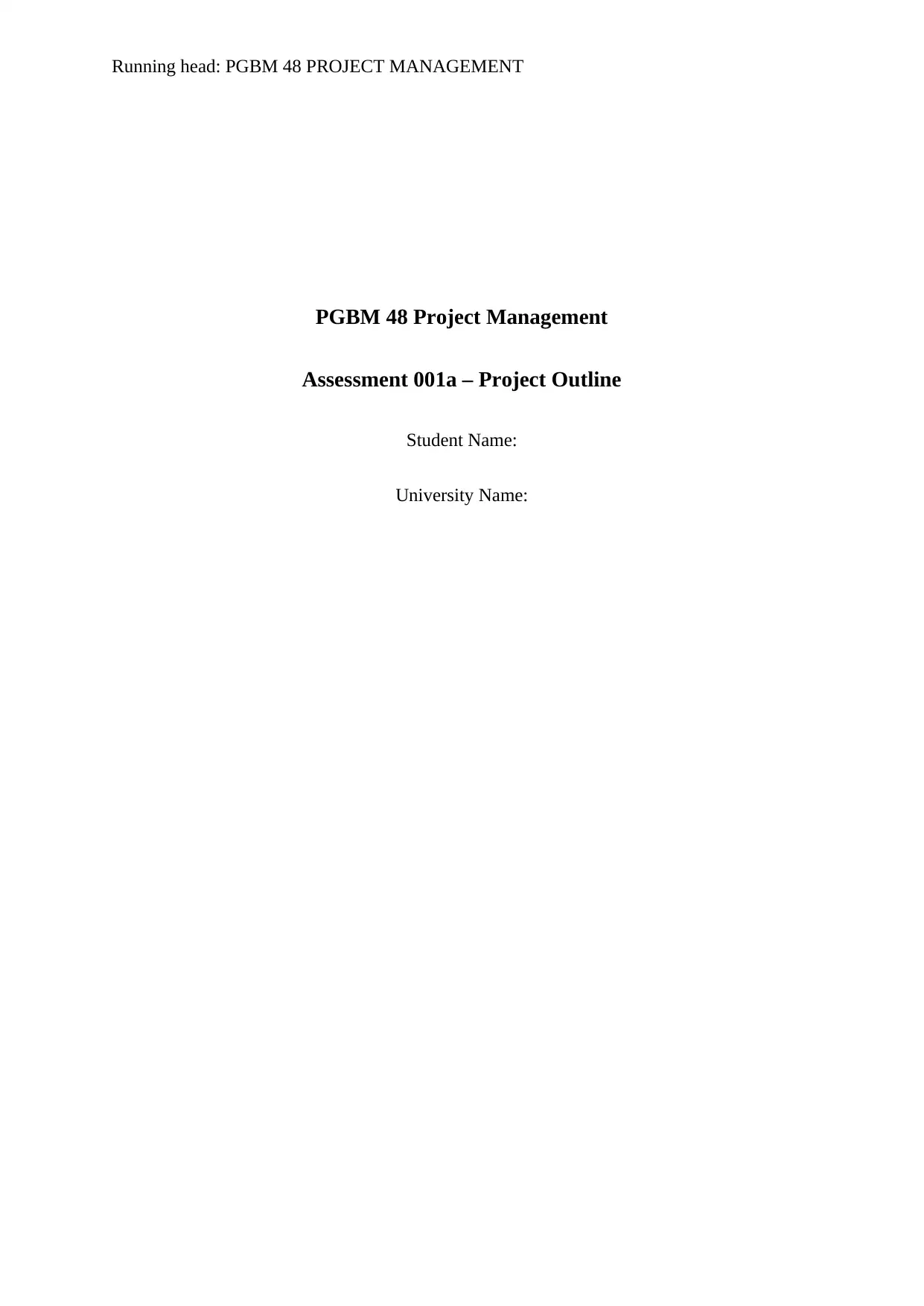
Running head: PGBM 48 PROJECT MANAGEMENT
PGBM 48 Project Management
Assessment 001a – Project Outline
Student Name:
University Name:
PGBM 48 Project Management
Assessment 001a – Project Outline
Student Name:
University Name:
Paraphrase This Document
Need a fresh take? Get an instant paraphrase of this document with our AI Paraphraser
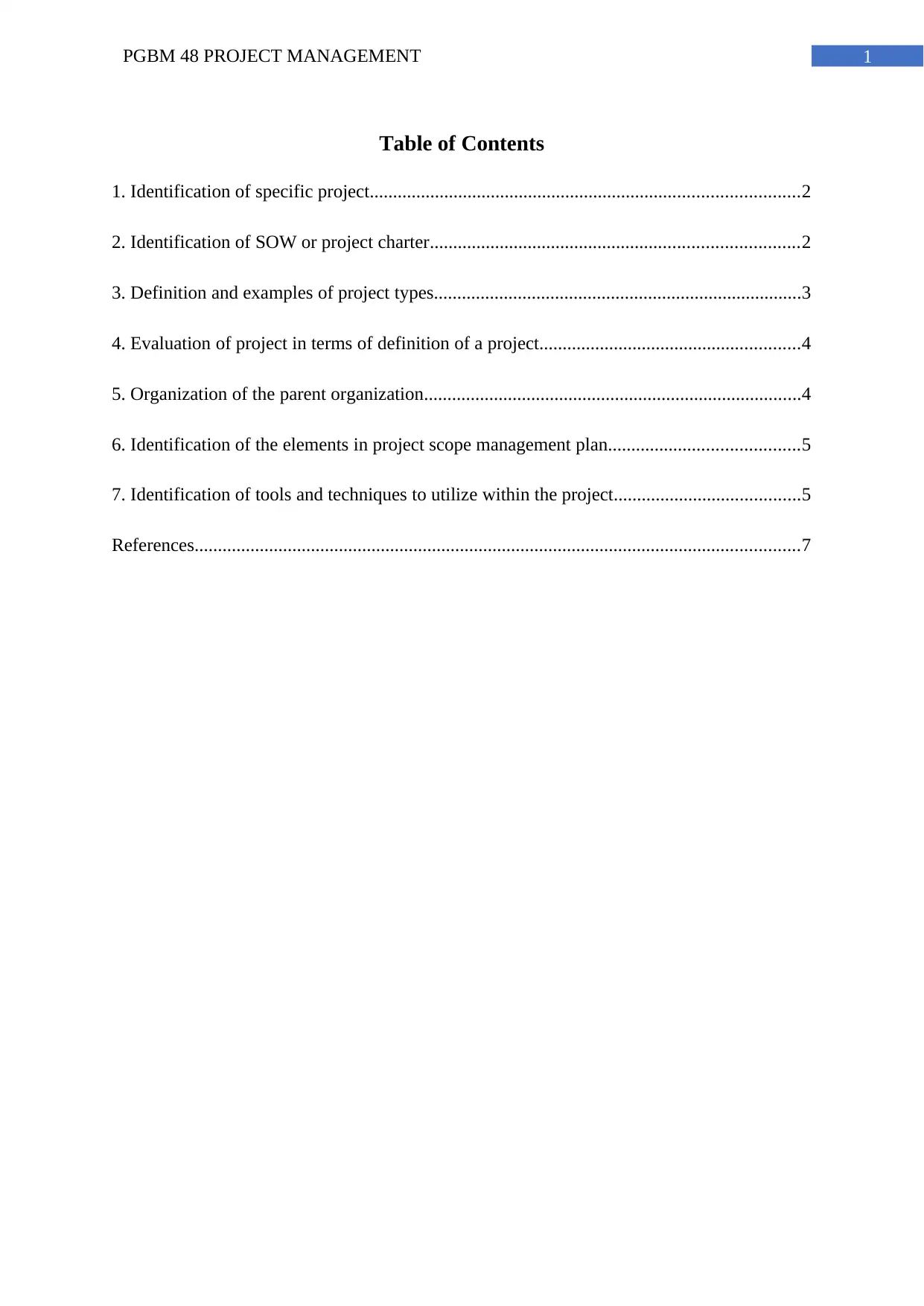
1PGBM 48 PROJECT MANAGEMENT
Table of Contents
1. Identification of specific project............................................................................................2
2. Identification of SOW or project charter...............................................................................2
3. Definition and examples of project types...............................................................................3
4. Evaluation of project in terms of definition of a project........................................................4
5. Organization of the parent organization.................................................................................4
6. Identification of the elements in project scope management plan.........................................5
7. Identification of tools and techniques to utilize within the project........................................5
References..................................................................................................................................7
Table of Contents
1. Identification of specific project............................................................................................2
2. Identification of SOW or project charter...............................................................................2
3. Definition and examples of project types...............................................................................3
4. Evaluation of project in terms of definition of a project........................................................4
5. Organization of the parent organization.................................................................................4
6. Identification of the elements in project scope management plan.........................................5
7. Identification of tools and techniques to utilize within the project........................................5
References..................................................................................................................................7
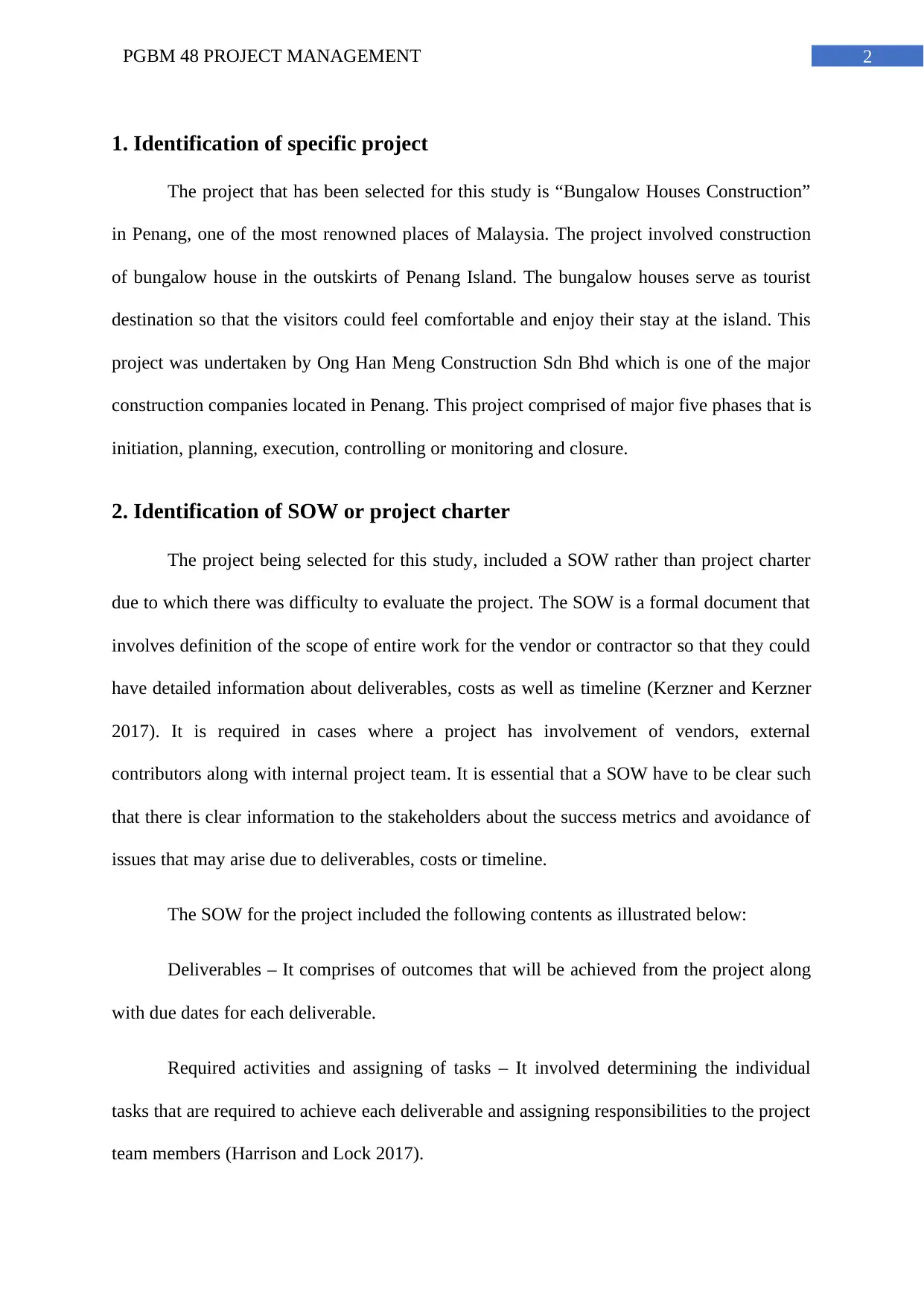
2PGBM 48 PROJECT MANAGEMENT
1. Identification of specific project
The project that has been selected for this study is “Bungalow Houses Construction”
in Penang, one of the most renowned places of Malaysia. The project involved construction
of bungalow house in the outskirts of Penang Island. The bungalow houses serve as tourist
destination so that the visitors could feel comfortable and enjoy their stay at the island. This
project was undertaken by Ong Han Meng Construction Sdn Bhd which is one of the major
construction companies located in Penang. This project comprised of major five phases that is
initiation, planning, execution, controlling or monitoring and closure.
2. Identification of SOW or project charter
The project being selected for this study, included a SOW rather than project charter
due to which there was difficulty to evaluate the project. The SOW is a formal document that
involves definition of the scope of entire work for the vendor or contractor so that they could
have detailed information about deliverables, costs as well as timeline (Kerzner and Kerzner
2017). It is required in cases where a project has involvement of vendors, external
contributors along with internal project team. It is essential that a SOW have to be clear such
that there is clear information to the stakeholders about the success metrics and avoidance of
issues that may arise due to deliverables, costs or timeline.
The SOW for the project included the following contents as illustrated below:
Deliverables – It comprises of outcomes that will be achieved from the project along
with due dates for each deliverable.
Required activities and assigning of tasks – It involved determining the individual
tasks that are required to achieve each deliverable and assigning responsibilities to the project
team members (Harrison and Lock 2017).
1. Identification of specific project
The project that has been selected for this study is “Bungalow Houses Construction”
in Penang, one of the most renowned places of Malaysia. The project involved construction
of bungalow house in the outskirts of Penang Island. The bungalow houses serve as tourist
destination so that the visitors could feel comfortable and enjoy their stay at the island. This
project was undertaken by Ong Han Meng Construction Sdn Bhd which is one of the major
construction companies located in Penang. This project comprised of major five phases that is
initiation, planning, execution, controlling or monitoring and closure.
2. Identification of SOW or project charter
The project being selected for this study, included a SOW rather than project charter
due to which there was difficulty to evaluate the project. The SOW is a formal document that
involves definition of the scope of entire work for the vendor or contractor so that they could
have detailed information about deliverables, costs as well as timeline (Kerzner and Kerzner
2017). It is required in cases where a project has involvement of vendors, external
contributors along with internal project team. It is essential that a SOW have to be clear such
that there is clear information to the stakeholders about the success metrics and avoidance of
issues that may arise due to deliverables, costs or timeline.
The SOW for the project included the following contents as illustrated below:
Deliverables – It comprises of outcomes that will be achieved from the project along
with due dates for each deliverable.
Required activities and assigning of tasks – It involved determining the individual
tasks that are required to achieve each deliverable and assigning responsibilities to the project
team members (Harrison and Lock 2017).
⊘ This is a preview!⊘
Do you want full access?
Subscribe today to unlock all pages.

Trusted by 1+ million students worldwide
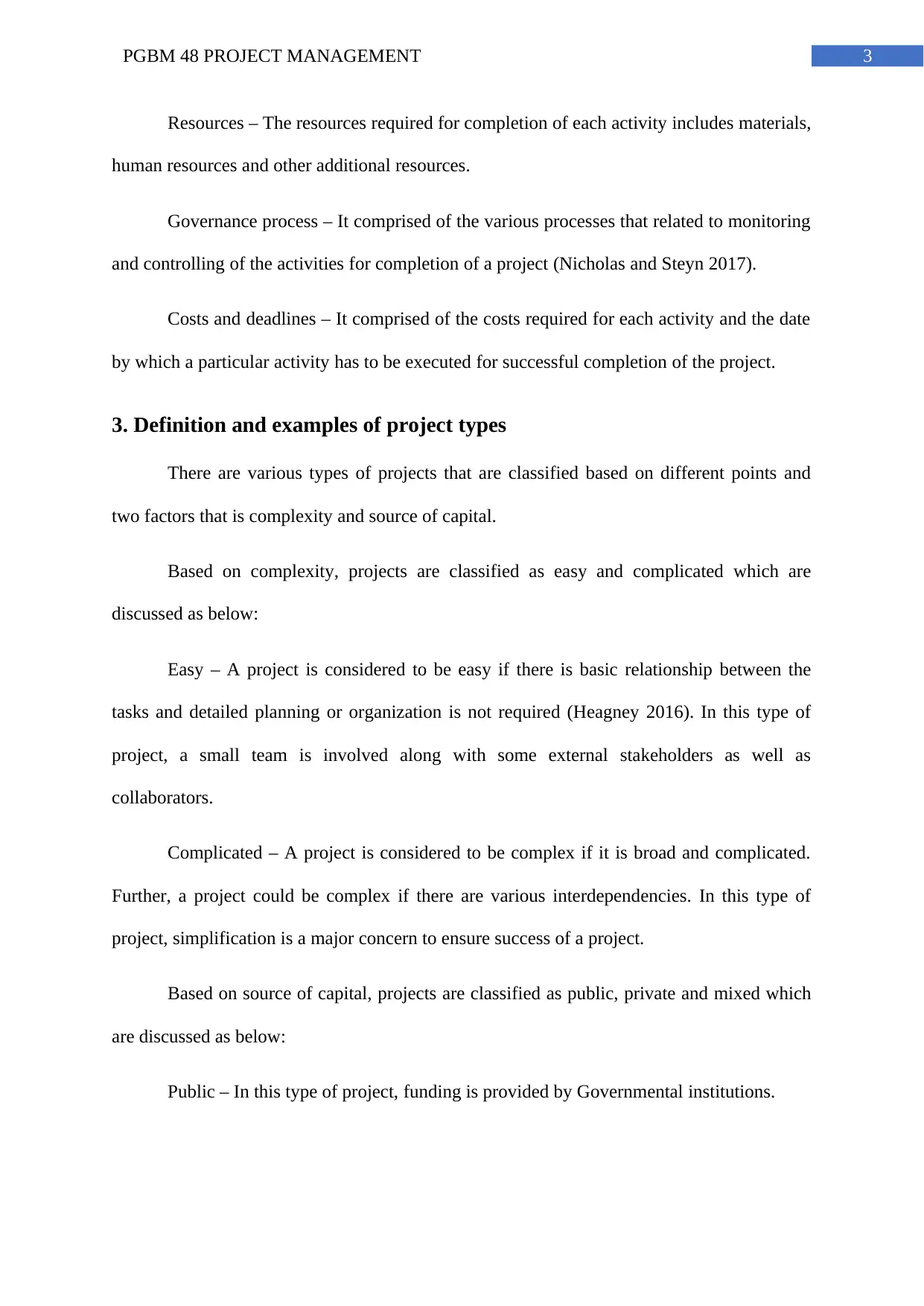
3PGBM 48 PROJECT MANAGEMENT
Resources – The resources required for completion of each activity includes materials,
human resources and other additional resources.
Governance process – It comprised of the various processes that related to monitoring
and controlling of the activities for completion of a project (Nicholas and Steyn 2017).
Costs and deadlines – It comprised of the costs required for each activity and the date
by which a particular activity has to be executed for successful completion of the project.
3. Definition and examples of project types
There are various types of projects that are classified based on different points and
two factors that is complexity and source of capital.
Based on complexity, projects are classified as easy and complicated which are
discussed as below:
Easy – A project is considered to be easy if there is basic relationship between the
tasks and detailed planning or organization is not required (Heagney 2016). In this type of
project, a small team is involved along with some external stakeholders as well as
collaborators.
Complicated – A project is considered to be complex if it is broad and complicated.
Further, a project could be complex if there are various interdependencies. In this type of
project, simplification is a major concern to ensure success of a project.
Based on source of capital, projects are classified as public, private and mixed which
are discussed as below:
Public – In this type of project, funding is provided by Governmental institutions.
Resources – The resources required for completion of each activity includes materials,
human resources and other additional resources.
Governance process – It comprised of the various processes that related to monitoring
and controlling of the activities for completion of a project (Nicholas and Steyn 2017).
Costs and deadlines – It comprised of the costs required for each activity and the date
by which a particular activity has to be executed for successful completion of the project.
3. Definition and examples of project types
There are various types of projects that are classified based on different points and
two factors that is complexity and source of capital.
Based on complexity, projects are classified as easy and complicated which are
discussed as below:
Easy – A project is considered to be easy if there is basic relationship between the
tasks and detailed planning or organization is not required (Heagney 2016). In this type of
project, a small team is involved along with some external stakeholders as well as
collaborators.
Complicated – A project is considered to be complex if it is broad and complicated.
Further, a project could be complex if there are various interdependencies. In this type of
project, simplification is a major concern to ensure success of a project.
Based on source of capital, projects are classified as public, private and mixed which
are discussed as below:
Public – In this type of project, funding is provided by Governmental institutions.
Paraphrase This Document
Need a fresh take? Get an instant paraphrase of this document with our AI Paraphraser
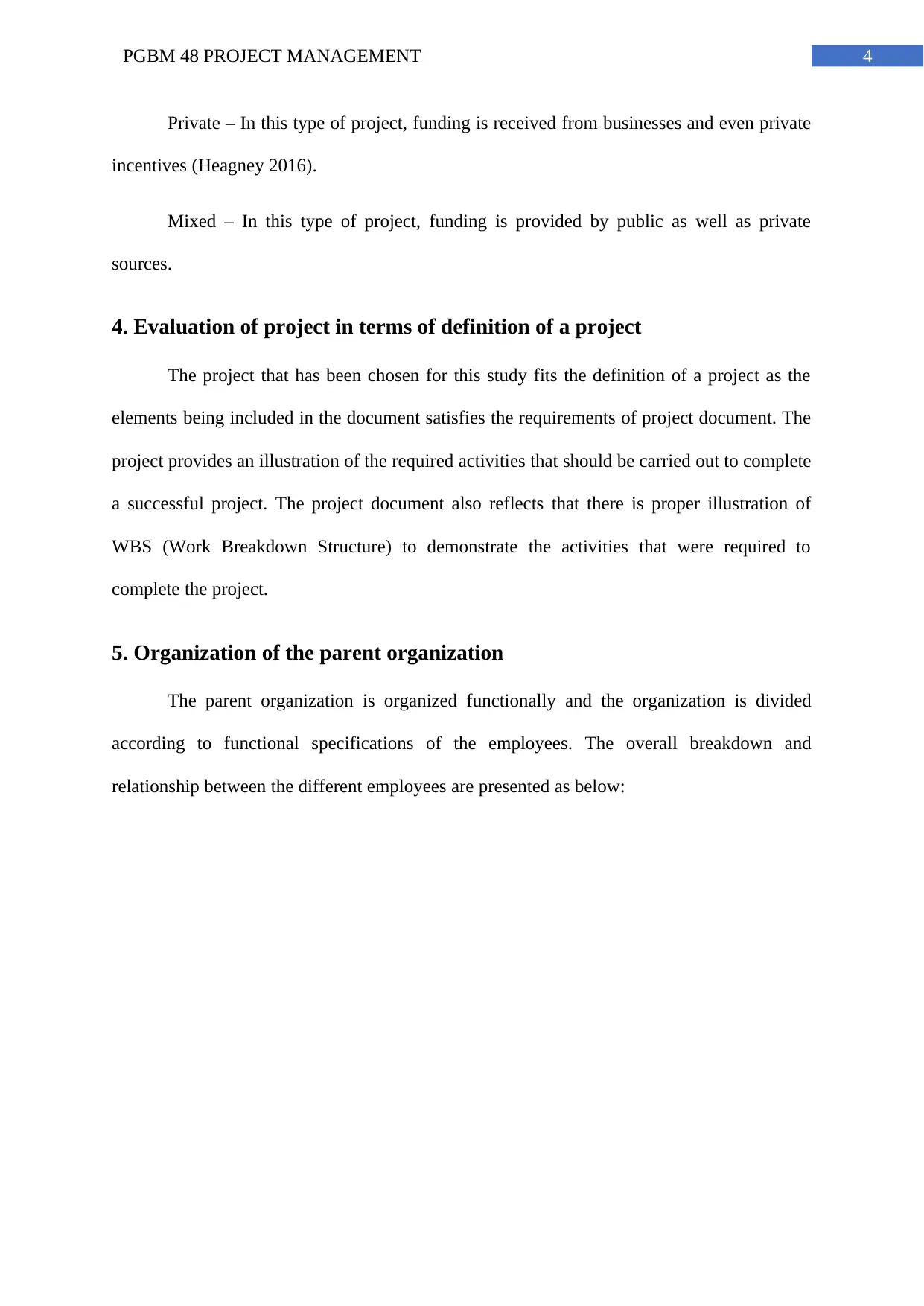
4PGBM 48 PROJECT MANAGEMENT
Private – In this type of project, funding is received from businesses and even private
incentives (Heagney 2016).
Mixed – In this type of project, funding is provided by public as well as private
sources.
4. Evaluation of project in terms of definition of a project
The project that has been chosen for this study fits the definition of a project as the
elements being included in the document satisfies the requirements of project document. The
project provides an illustration of the required activities that should be carried out to complete
a successful project. The project document also reflects that there is proper illustration of
WBS (Work Breakdown Structure) to demonstrate the activities that were required to
complete the project.
5. Organization of the parent organization
The parent organization is organized functionally and the organization is divided
according to functional specifications of the employees. The overall breakdown and
relationship between the different employees are presented as below:
Private – In this type of project, funding is received from businesses and even private
incentives (Heagney 2016).
Mixed – In this type of project, funding is provided by public as well as private
sources.
4. Evaluation of project in terms of definition of a project
The project that has been chosen for this study fits the definition of a project as the
elements being included in the document satisfies the requirements of project document. The
project provides an illustration of the required activities that should be carried out to complete
a successful project. The project document also reflects that there is proper illustration of
WBS (Work Breakdown Structure) to demonstrate the activities that were required to
complete the project.
5. Organization of the parent organization
The parent organization is organized functionally and the organization is divided
according to functional specifications of the employees. The overall breakdown and
relationship between the different employees are presented as below:
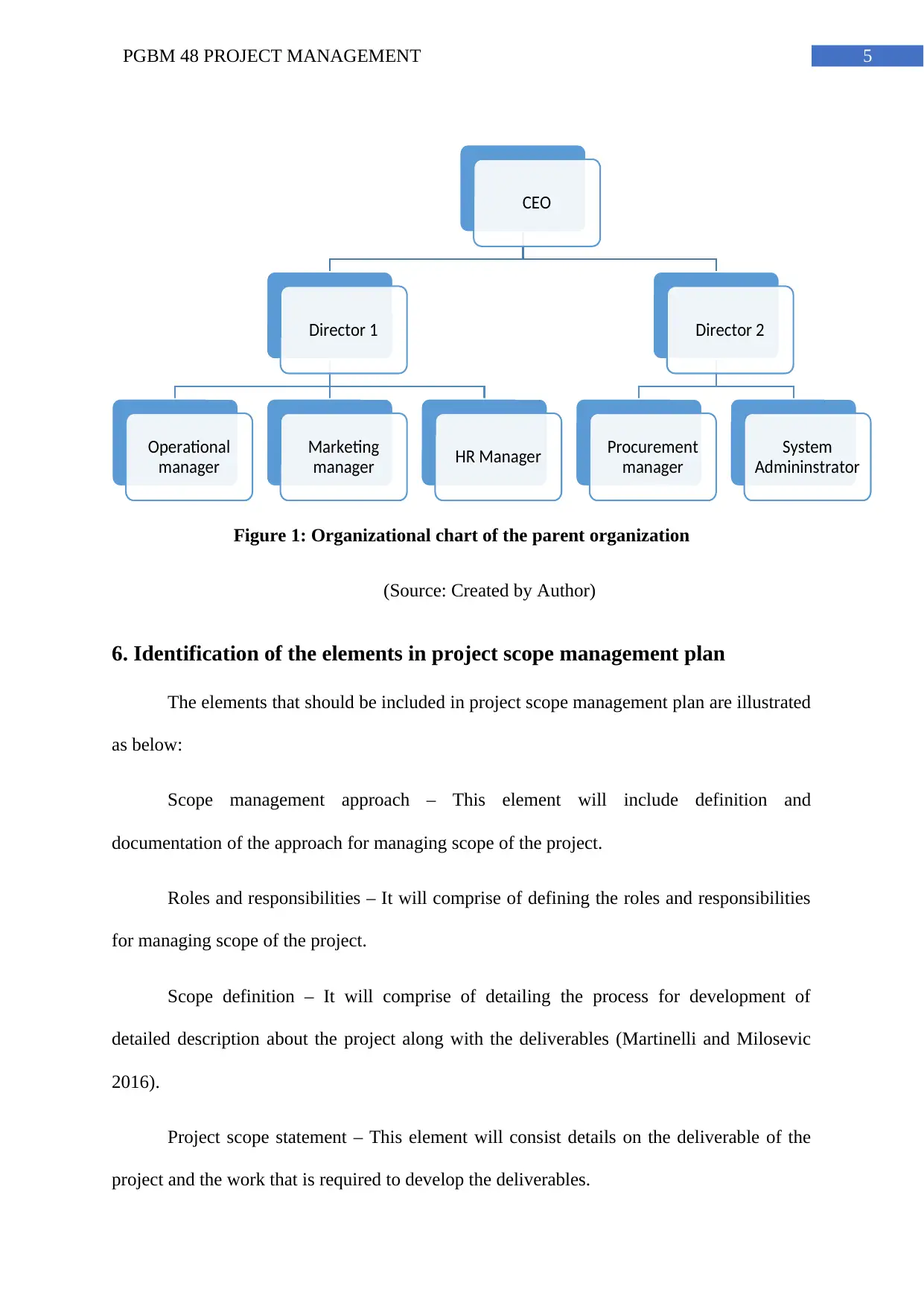
5PGBM 48 PROJECT MANAGEMENT
Figure 1: Organizational chart of the parent organization
(Source: Created by Author)
6. Identification of the elements in project scope management plan
The elements that should be included in project scope management plan are illustrated
as below:
Scope management approach – This element will include definition and
documentation of the approach for managing scope of the project.
Roles and responsibilities – It will comprise of defining the roles and responsibilities
for managing scope of the project.
Scope definition – It will comprise of detailing the process for development of
detailed description about the project along with the deliverables (Martinelli and Milosevic
2016).
Project scope statement – This element will consist details on the deliverable of the
project and the work that is required to develop the deliverables.
CEO
Director 1
Operational
manager
Marketing
manager HR Manager
Director 2
Procurement
manager
System
Admininstrator
Figure 1: Organizational chart of the parent organization
(Source: Created by Author)
6. Identification of the elements in project scope management plan
The elements that should be included in project scope management plan are illustrated
as below:
Scope management approach – This element will include definition and
documentation of the approach for managing scope of the project.
Roles and responsibilities – It will comprise of defining the roles and responsibilities
for managing scope of the project.
Scope definition – It will comprise of detailing the process for development of
detailed description about the project along with the deliverables (Martinelli and Milosevic
2016).
Project scope statement – This element will consist details on the deliverable of the
project and the work that is required to develop the deliverables.
CEO
Director 1
Operational
manager
Marketing
manager HR Manager
Director 2
Procurement
manager
System
Admininstrator
⊘ This is a preview!⊘
Do you want full access?
Subscribe today to unlock all pages.

Trusted by 1+ million students worldwide
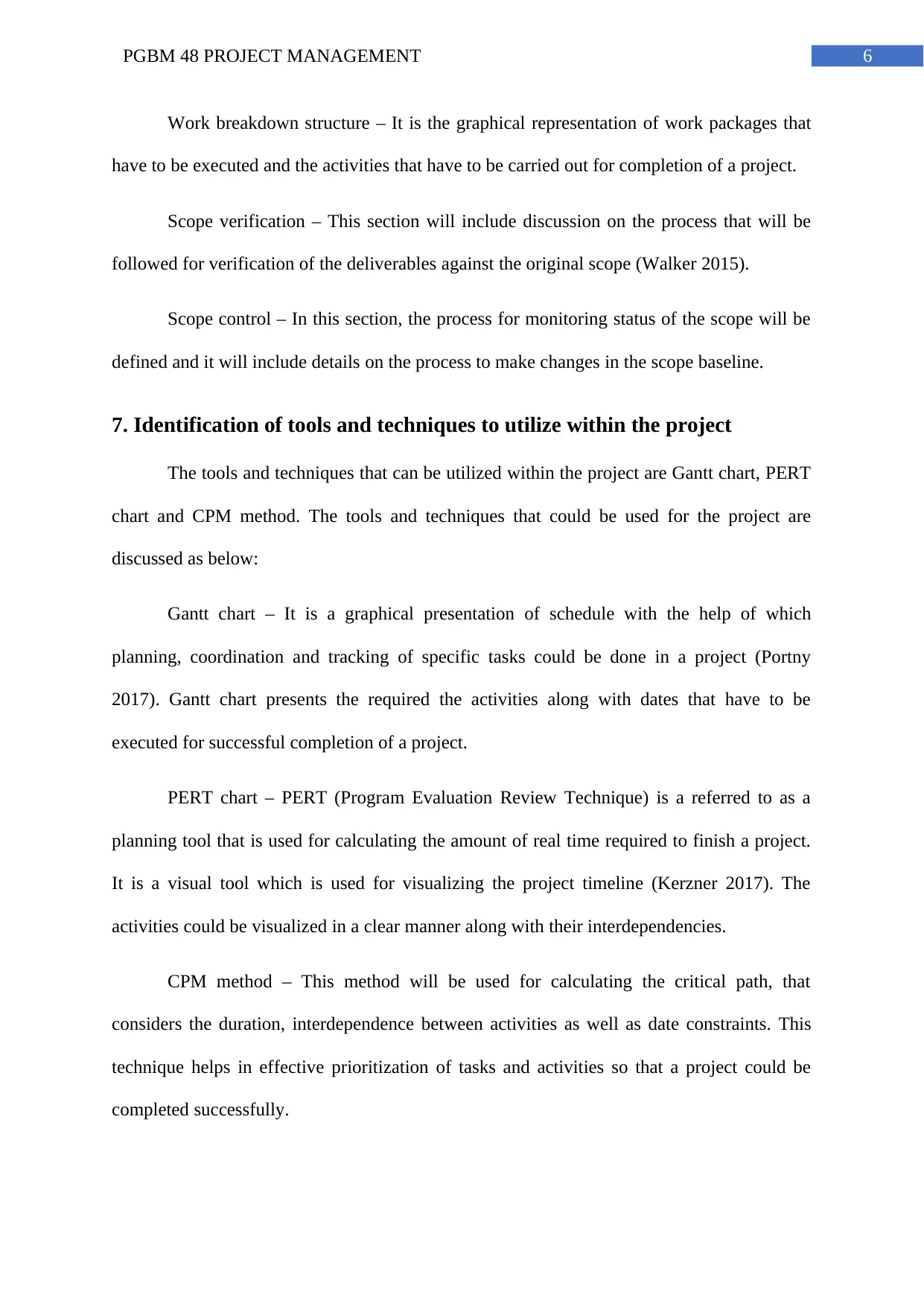
6PGBM 48 PROJECT MANAGEMENT
Work breakdown structure – It is the graphical representation of work packages that
have to be executed and the activities that have to be carried out for completion of a project.
Scope verification – This section will include discussion on the process that will be
followed for verification of the deliverables against the original scope (Walker 2015).
Scope control – In this section, the process for monitoring status of the scope will be
defined and it will include details on the process to make changes in the scope baseline.
7. Identification of tools and techniques to utilize within the project
The tools and techniques that can be utilized within the project are Gantt chart, PERT
chart and CPM method. The tools and techniques that could be used for the project are
discussed as below:
Gantt chart – It is a graphical presentation of schedule with the help of which
planning, coordination and tracking of specific tasks could be done in a project (Portny
2017). Gantt chart presents the required the activities along with dates that have to be
executed for successful completion of a project.
PERT chart – PERT (Program Evaluation Review Technique) is a referred to as a
planning tool that is used for calculating the amount of real time required to finish a project.
It is a visual tool which is used for visualizing the project timeline (Kerzner 2017). The
activities could be visualized in a clear manner along with their interdependencies.
CPM method – This method will be used for calculating the critical path, that
considers the duration, interdependence between activities as well as date constraints. This
technique helps in effective prioritization of tasks and activities so that a project could be
completed successfully.
Work breakdown structure – It is the graphical representation of work packages that
have to be executed and the activities that have to be carried out for completion of a project.
Scope verification – This section will include discussion on the process that will be
followed for verification of the deliverables against the original scope (Walker 2015).
Scope control – In this section, the process for monitoring status of the scope will be
defined and it will include details on the process to make changes in the scope baseline.
7. Identification of tools and techniques to utilize within the project
The tools and techniques that can be utilized within the project are Gantt chart, PERT
chart and CPM method. The tools and techniques that could be used for the project are
discussed as below:
Gantt chart – It is a graphical presentation of schedule with the help of which
planning, coordination and tracking of specific tasks could be done in a project (Portny
2017). Gantt chart presents the required the activities along with dates that have to be
executed for successful completion of a project.
PERT chart – PERT (Program Evaluation Review Technique) is a referred to as a
planning tool that is used for calculating the amount of real time required to finish a project.
It is a visual tool which is used for visualizing the project timeline (Kerzner 2017). The
activities could be visualized in a clear manner along with their interdependencies.
CPM method – This method will be used for calculating the critical path, that
considers the duration, interdependence between activities as well as date constraints. This
technique helps in effective prioritization of tasks and activities so that a project could be
completed successfully.
Paraphrase This Document
Need a fresh take? Get an instant paraphrase of this document with our AI Paraphraser

7PGBM 48 PROJECT MANAGEMENT
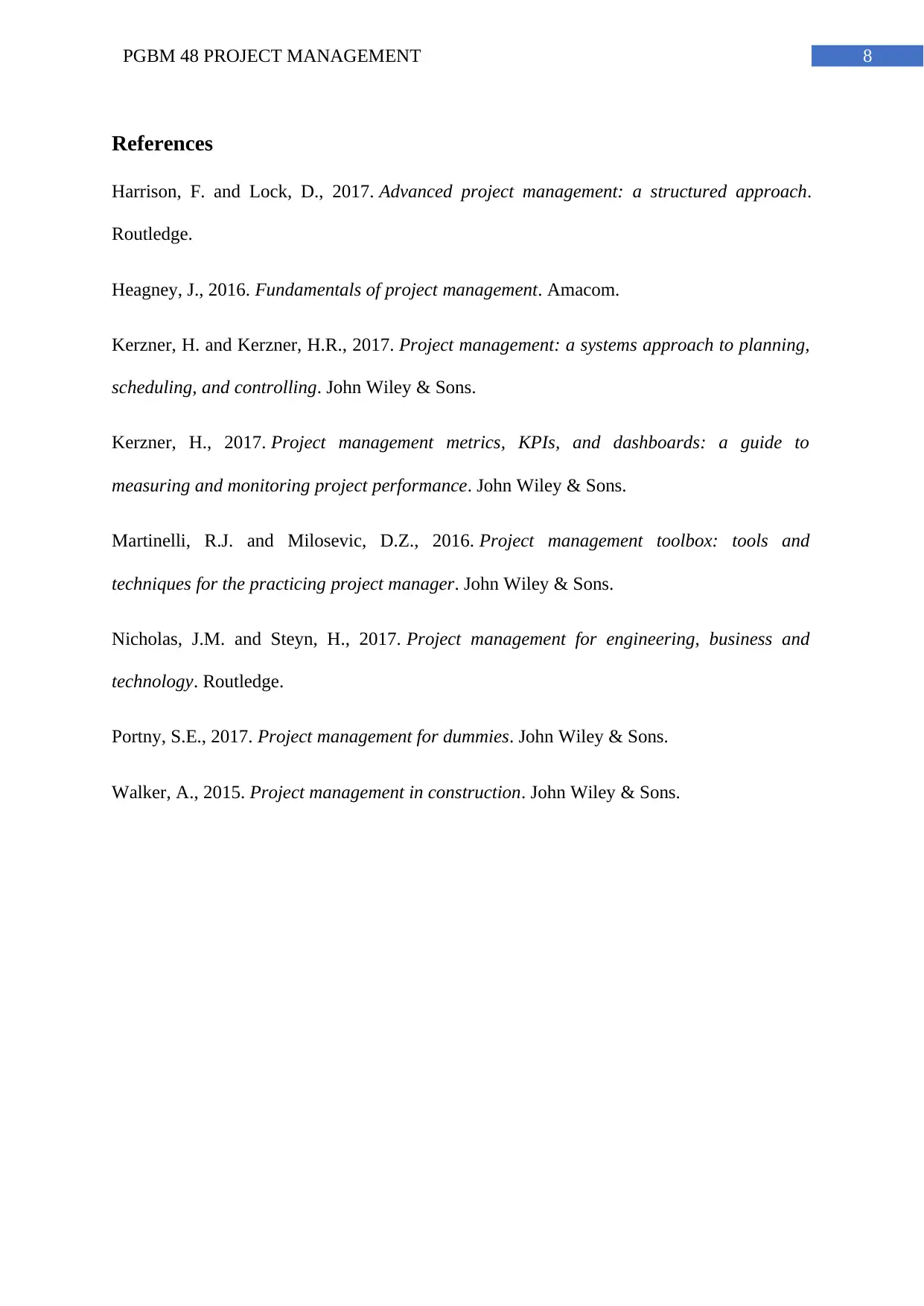
8PGBM 48 PROJECT MANAGEMENT
References
Harrison, F. and Lock, D., 2017. Advanced project management: a structured approach.
Routledge.
Heagney, J., 2016. Fundamentals of project management. Amacom.
Kerzner, H. and Kerzner, H.R., 2017. Project management: a systems approach to planning,
scheduling, and controlling. John Wiley & Sons.
Kerzner, H., 2017. Project management metrics, KPIs, and dashboards: a guide to
measuring and monitoring project performance. John Wiley & Sons.
Martinelli, R.J. and Milosevic, D.Z., 2016. Project management toolbox: tools and
techniques for the practicing project manager. John Wiley & Sons.
Nicholas, J.M. and Steyn, H., 2017. Project management for engineering, business and
technology. Routledge.
Portny, S.E., 2017. Project management for dummies. John Wiley & Sons.
Walker, A., 2015. Project management in construction. John Wiley & Sons.
References
Harrison, F. and Lock, D., 2017. Advanced project management: a structured approach.
Routledge.
Heagney, J., 2016. Fundamentals of project management. Amacom.
Kerzner, H. and Kerzner, H.R., 2017. Project management: a systems approach to planning,
scheduling, and controlling. John Wiley & Sons.
Kerzner, H., 2017. Project management metrics, KPIs, and dashboards: a guide to
measuring and monitoring project performance. John Wiley & Sons.
Martinelli, R.J. and Milosevic, D.Z., 2016. Project management toolbox: tools and
techniques for the practicing project manager. John Wiley & Sons.
Nicholas, J.M. and Steyn, H., 2017. Project management for engineering, business and
technology. Routledge.
Portny, S.E., 2017. Project management for dummies. John Wiley & Sons.
Walker, A., 2015. Project management in construction. John Wiley & Sons.
⊘ This is a preview!⊘
Do you want full access?
Subscribe today to unlock all pages.

Trusted by 1+ million students worldwide
1 out of 9
Related Documents
Your All-in-One AI-Powered Toolkit for Academic Success.
+13062052269
info@desklib.com
Available 24*7 on WhatsApp / Email
![[object Object]](/_next/static/media/star-bottom.7253800d.svg)
Unlock your academic potential
Copyright © 2020–2025 A2Z Services. All Rights Reserved. Developed and managed by ZUCOL.



